Categories: Sources of light, All about LEDs
Number of views: 78746
Comments on the article: 0
Types, characteristics, marking of SMD LEDs
Lighting is an important condition for work and human comfort. For a long time, incandescent lamps were used as light sources, then fluorescent lamps, halogen lamps, DRL and DNaT were used for powerful spotlights and flashlights.
In the 21st century, the generation of lighting fixtures has changed, and LED lamps occupy more than half of the market, they are often called foreign lamps or LED lamps. Depending on the design and power, they are either LED COB-matrices or assemblies from individual LEDs.
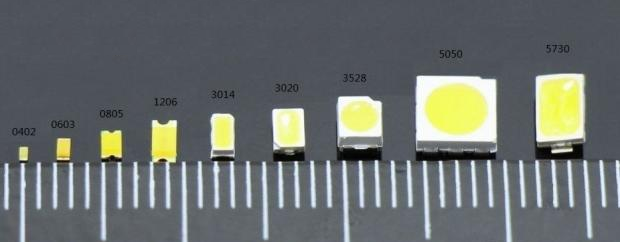
Varieties of LEDs
The first LED fixtures and lamps were built on the basis of 5 mm output LEDs. They were not distinguished by high energy efficiency, price and reliability, but this was the first step in the development of a new light source. For a long time, such LEDs were used as indicators for household and industrial equipment and as emitters for portable flashlights.
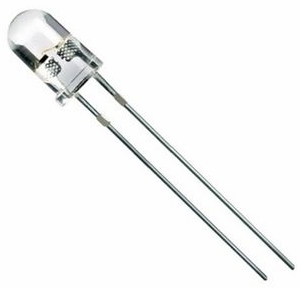
Later they were replaced by LEDs made in lead-free cases, the so-called SMD (surface mounted device, Russian devices for surface mounting).
If 5 mm LEDs were mounted in the board through the holes, then the SMDs are sealed directly on the surface of the board, which speeds up their assembly and reduces the cost of the lamp. Instead of legs, they have contact metal pads, from 2 or more pieces, depending on the number of colors and crystals in one case.
In general, there are three types of LEDs:
1. Outlets (3, 5, 10 mm - the diameter of the flask and others).
2. SMD (we will consider their diversity in this article).

3. COB LEDs are arrays of crystals located on a circuit board under a single phosphor layer. It stands for Chip-On-Board, Russian. chips on the board. Their appearance in the figure above.
SMD LEDs use in lamps with various sockets, floodlights, LED strips, LED desk lamps and other lighting fixtures.
Characteristics of SMD LEDs
Initially, the most popular models of LEDs 3528 and 5050, now they are found mainly on led strips, they are practically not used in lamps, giving preference to 5630 LEDs and other modern models.
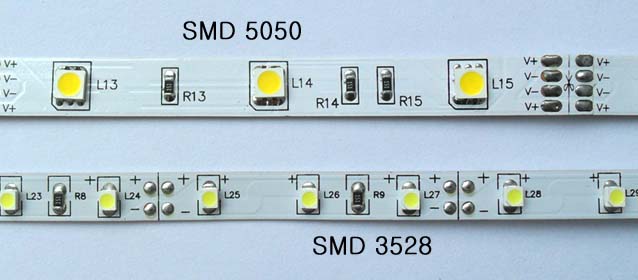
SMD LEDs in their marking contain their overall dimensions - length and width, while the original LEDs in each type of housing, regardless of whether this is 3528 or 5730, has its own type of LED crystal with special characteristics.
Unfortunately, Chinese manufacturers under the guise of modern 5730 do not disdain the sale of 3528 crystals in the new building. In the review, I will not indicate the supply voltage, because for all white LEDs it usually lies within 2.8 - 3.4V.
SMD3528 Specifications
The 3528 LEDs are something like an analogue of a standard 5 mm LED, but in an SMD package. Have characteristics:
-
current - 20 mA;
-
power - 0.06 W;
-
luminous flux - 5-7 lm;
-
dimensions - 3.5x2.8x1.4 mm;
-
temperature up to 80 ° C;
-
on the front of the case there is a slice - on this side the cathode (minus).
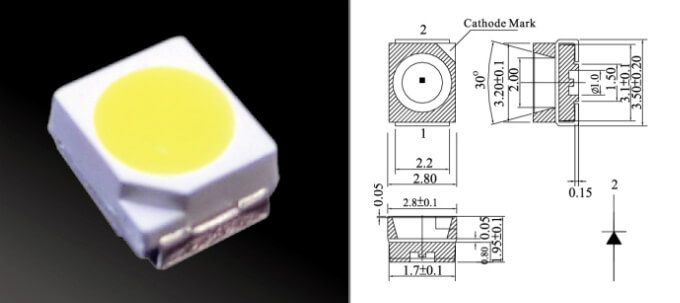
In LED strips, they are installed in quantities of 30, 60, 120 pcs / m, they are used mainly for illumination, less often for lighting, because pretty weak. A tape of 120 pcs / m out of 3528 consumes 9.6 W / m.
SMD5050 Specifications
The 5050 LED contains in its case three of the same crystals as in 3528, which means it is three times more powerful.
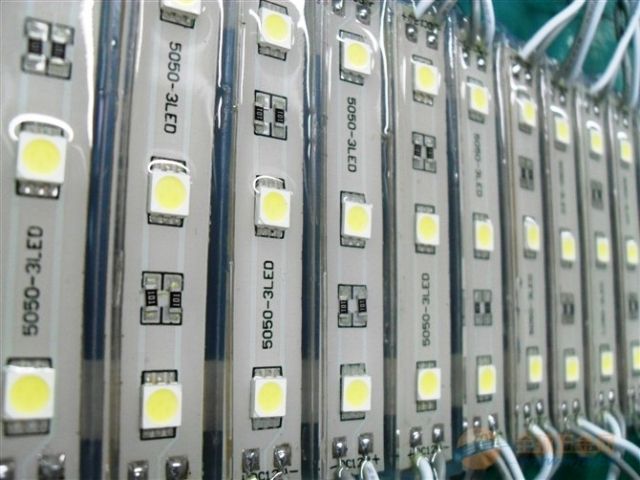
The design is very interesting: on its "belly" you will see 6 conclusions, these are the anodes and cathodes, one pair from each crystal.
-
current - 3x0.02 A = 0.06 A total current with parallel connection of crystals;
-
power - 3x0.06 W total up to 0.02 W;
-
luminous flux - up to 20 Lm
-
dimensions - 5x5x1.6 mm;
-
recommended temperature up to 60 ° C;
-
cathodes on the cut side at the corner of the casing.
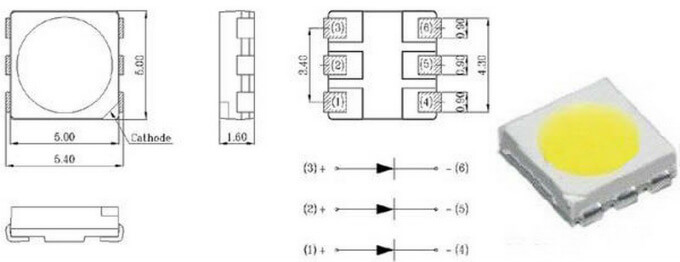
30 and 60 diodes per meter are usually installed on the tape.A strip with 60 LEDs of type 5050 consumes 14.4 W / m, and can be successfully used for lighting. Often found in RGB and RGBW versions.

SMD 5630 Specifications
LEDs 5630 are more modern and more technologically advanced, they are used in searchlights, lamps, and are installed on LED strips. There are 4 pins on the case.
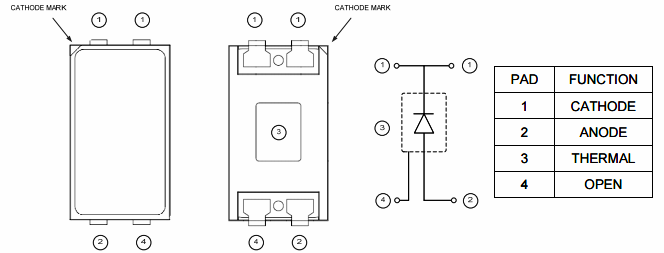
The pinout you see in the figure above, the cathode from the side of the cut corner.

Specifications:
-
Current - 0.15-0.2 A;
-
Power - 0.5 W;
-
The maximum crystal temperature is 130 ° C;
-
Luminous flux 40 Lm.
-
Dimensions 5.6x3x0.75 mm
60 pcs / m are most often supplied in tapes, as well as metal rulers with the number of diodes 72pcs, 12V power. Such a tape consumes up to 18 W / m, can be used for the main lighting of a room, or decorative lighting, for example in niches of a false ceiling. There are in RGB performance.
SMD 5730 - Specifications
Very similar to the previous ones, they are available in versions 5730-05 and 5730-1, at 0.5 and 1 W, respectively. Possess a little more light stream. Unlike 5630, 5730 has two outputs, and their length is slightly larger.

Specifications:
-
current - 0.15 / 0.3 A;
-
power - 0.5 / 1 W;
-
luminous flux - 55/110 Lm;
-
dimensions taking into account the length of the terminals - 5.7х3х0.75 mm.
You may have noticed that this and the previous LED, in addition to the terminals for connection, have a metal pad on the bottom, it is needed to remove heat. Such a constructive solution allowed the successful use of high power chips. By the way, it will also help determine the pinout of the LED, the heat sink on them is shifted to the ANODE.
SMD 2835 - Specifications
This is not a typo, the 2835 marking is often confused with the 3528, but these are completely different generations of LEDs. LED 2835 is more modern and brighter. The first difference that catches your eye is the area covered by the phosphor in 3528 is round, and in 2835 it is closer to the rectangle. The luminous flux of the first is up to 40 Lm / W, and for 2835 more than 110 Lm / W, which is 2-3 times brighter, with the same power consumption.

The increase in power made it necessary to improve heat transfer, so the 2835 case was made thinner, and the contact pads were larger. Industry produces 0.2, 0.5 and 1W. However, do not forget that the more power, the more heat is generated and with such small sizes it is very important.
Specifications:
-
Current - 0.06 A;
-
Power - 0.2 W;
-
Luminous flux - 25 Lm;
-
Operating temperature - 65 ° C;
-
Dimensions - 2.8x3.5x0.95 mm.
30, 60, 120 pieces per meter are also mounted on LED strips. For example, a tape with a LED density of 60 pcs / m consumes 4.8 W / m, due to its characteristics it is much more effective in terms of energy saving and lighting than 3528, it can be used as a light source and decorative illumination.
Summary table of characteristics SMD 3014, 7020, 3020
LEDs that are less common, I decided to consider all together in a summary table.
LEDs 3014 are very compact, better suited for decorative lighting, their appearance is shown below.
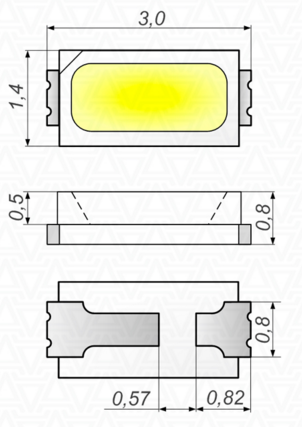
On the tape, they look as follows. Tapes are sold in standard dimensions of 30-120 pcs / m, and there are also 240 pcs / m, but less often.
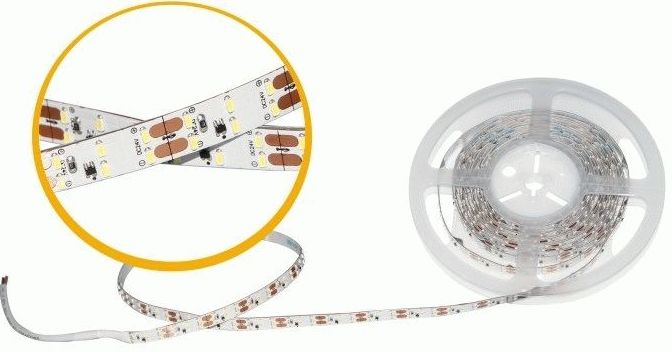
7020 LEDs are very bright, long and narrow, which allows them to be tightly mounted on the board, found in tapes, on metal strips and in searchlights.

Such metal strips with 7020 LEDs provide good heat dissipation, which significantly improves working conditions and increases the service life.

Personally, I am skeptical of classic flexible tapes with 7020s due to the high power of the LEDs, but there are 60 pcs / m on sale.
Conclusion
Unfortunately, the quality of most LED products is poor. Manufacturers either neglect the diode switching circuits, or power sources, or even purchase low-grade fakes for their devices. Therefore, I did not indicate such a parameter as color rendering index. It greatly depends on the quality of the phosphor.
Moreover, there is information on the network that they learned to deceive the CRI system for determining the color rendering index, and a phosphor consists of such components that form a luminous flux with peaks in the spectrum at the desired wavelengths for a successful test.
It turns out that with a high index, the real difference in the colors of the eye suffers. It is pointless to indicate the service life; for LEDs, it usually ranges from 30 to 50 thousand hours, but it depends heavily on the power source (or rather the quality of the power supply), the thermal regime and the operating mode as a whole.
Also, I did not indicate the angle of illumination, since on all SMD LEDs it lies within 105-135 °, and the most common - 120 °.
As a result, the conclusion suggests itself that such a popular product as an LED actually makes it difficult to find the right quality. If you want to get a decent light, it is better to pay attention to the products of trusted manufacturers, for example OSRAM, Philips, CREE.
See also at bgv.electricianexp.com
:
